How Long Are Leftover Wings Good for
Your leftover wings will stay fresh in the refrigerator for 3-4 days when stored properly in an airtight container at or below 40°F. Don't leave them at room temperature for more than 2 hours (1 hour if it's above 90°F) to prevent bacterial growth. For longer storage, you can freeze wings for up to 4 months if they're cooked, or 6-9 months if they're raw. Always check for signs of spoilage like off-odors, slimy texture, or discoloration before consuming. When reheating, make certain wings reach an internal temperature of 165°F for safe consumption. These storage guidelines will help you maximize your wings' shelf life while maintaining food safety.
This post may contain affiliate links. If you make a purchase through these links, I may earn a commission at no additional cost to you. Additionally, portions of this post may be generated using artificial intelligence (AI) technology. While we strive for accuracy, please be aware that AI-generated content may not always be perfect and should be fact-checked when necessary.
The Spatula Scoops
- Properly stored leftover wings remain safe in the refrigerator for 3-4 days when kept at or below 40°F.
- Wings should be refrigerated within 2 hours of cooking, or within 1 hour if the temperature exceeds 90°F.
- Frozen wings maintain best quality for up to 4 months when stored at 0°F in airtight containers or freezer bags.
- Discard wings that show signs of spoilage like gray-green coloring, slimy texture, or sour/rancid odors.
- When reheating, wings must reach an internal temperature of 165°F to ensure safe consumption.
Safe Storage Guidelines
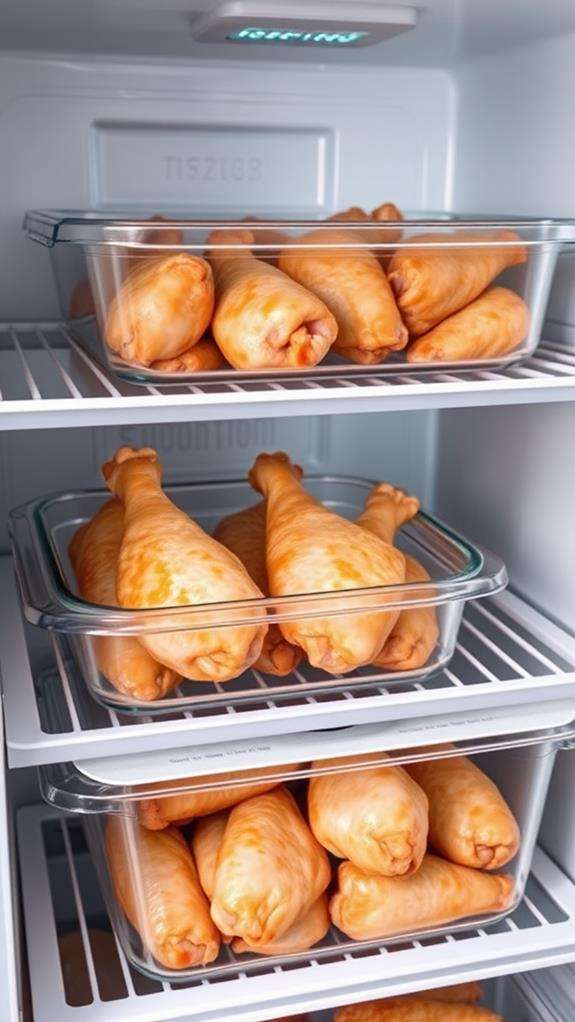
The safe storage of leftover chicken wings starts with proper handling immediately after cooking. You'll need to let your wings cool to room temperature for no more than two hours before refrigerating them, as bacteria multiply rapidly in the "danger zone" between 40°F and 140°F.
When you're ready to store your wings, place them in an airtight container or wrap them tightly in aluminum foil or plastic wrap. If you're using a container, make certain it's shallow enough to allow for quick cooling throughout. You'll want to separate your wings into smaller portions rather than storing them in one large batch, which helps prevent moisture buildup and guarantees even cooling.
Label your containers with the date you're storing them, and place them in the refrigerator's main compartment where the temperature stays consistently below 40°F. Don't stack containers on top of each other, as this can prevent proper air circulation. For ideal freshness, store your wings away from raw meats and strong-smelling foods, as cooked poultry can absorb other flavors. If you've got sauce-covered wings, store them separately from plain ones to maintain their distinct flavors.
Room Temperature Storage Limits
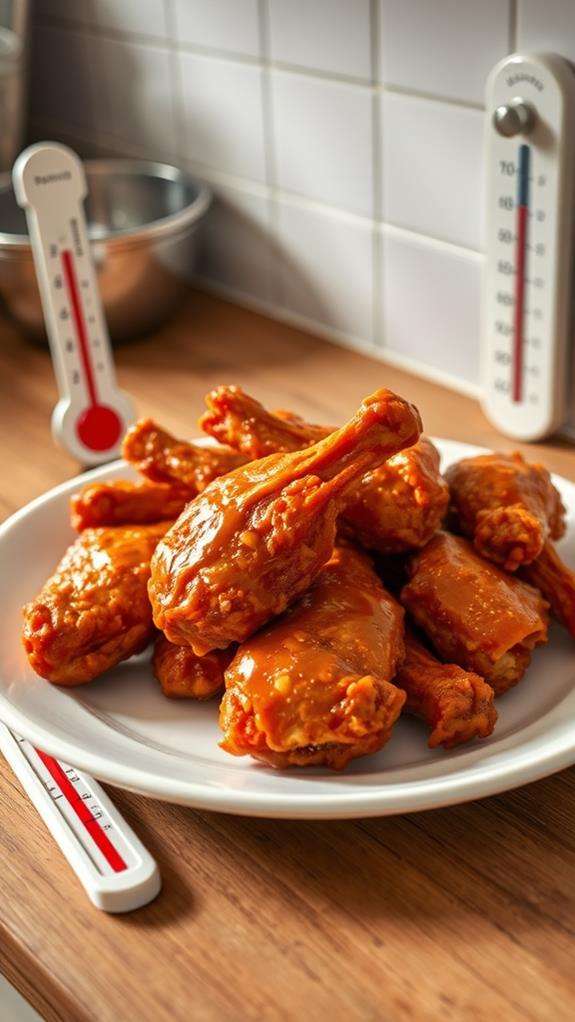
When dealing with leftover wings at room temperature, you shouldn't leave them out for more than two hours, or one hour if the ambient temperature exceeds 90°F. This time limit exists because bacteria multiply rapidly in what food safety experts call the "danger zone," which ranges from 40°F to 140°F (4°C to 60°C).
You'll need to pay close attention to the clock once your wings come off the heat. Bacteria can double in number every 20 minutes at room temperature, making your wings unsafe to eat surprisingly quickly. If you've got wings sitting out during a party or gathering, you'll want to set a timer to remind yourself when it's time to refrigerate them. Don't try to "save" wings that have been left out too long – even if they look and smell fine, they could harbor dangerous bacteria like Salmonella or E. coli.
If you're serving wings at an outdoor event, you'll need to be even more vigilant. Higher temperatures speed up bacterial growth, so you'll want to keep them in a cooler with ice when they're not being eaten.
Best Refrigeration Practices

You'll want to store your leftover wings at or below 40°F (4°C) in your refrigerator, as this temperature range considerably slows bacterial growth and helps maintain food safety. For the best results, transfer your wings to an airtight container or wrap them tightly in heavy-duty aluminum foil, which prevents both moisture loss and the absorption of other food odors. If you're using plastic containers, make sure they're clean, completely sealed, and large enough to hold the wings without crushing them, as damaged wings can create moisture pockets that accelerate spoilage.
Proper Storage Temperature
Proper storage temperature plays a critical role in keeping leftover wings safe to eat. You'll need to maintain your refrigerator at or below 40°F (4°C) to prevent harmful bacteria from multiplying rapidly. This temperature range considerably slows down bacterial growth, which can start accelerating in what food safety experts call the "danger zone" between 40°F and 140°F (4°C-60°C).
For ideal food safety, you should check your refrigerator's temperature regularly using a reliable appliance thermometer. Don't rely on the built-in temperature dial, as it might not be accurately calibrated. Place your leftover wings in shallow, airtight containers that allow for quick cooling, and verify they reach the safe temperature zone within two hours of cooking. If you're storing multiple containers of wings, don't stack them too tightly – proper air circulation is essential for maintaining consistent temperature throughout the refrigerator. The bottom shelf is often the coldest part of your fridge, making it an ideal spot for storing perishable items like leftover wings. You'll want to avoid storing them in the door compartments, where temperatures can fluctuate due to frequent opening.
Airtight Container Usage
The choice of storage container can make or break the freshness of your leftover wings. When storing wings in your refrigerator, you'll want to select an airtight container that prevents both moisture loss and bacterial contamination. Glass or high-quality plastic containers with secure, snap-tight lids are your best options for maintaining ideal freshness.
To guarantee maximum preservation of your leftover wings, follow these essential container guidelines:
- Use containers with rubber or silicone seals that create an airtight barrier against moisture and outside contaminants
- Select appropriately sized containers that minimize excess air space while accommodating the wings without crushing them
- Choose containers that are microwave-safe if you plan to reheat your wings directly in the storage vessel
- Avoid using the original takeout containers, which often aren't sufficiently airtight for extended storage
If you're stacking multiple layers of wings, place a sheet of wax paper or parchment between layers to prevent sticking. You'll also want to make sure your container is thoroughly clean and dry before storing your wings, as any residual moisture can accelerate spoilage and compromise food safety.
Signs of Spoiled Wings
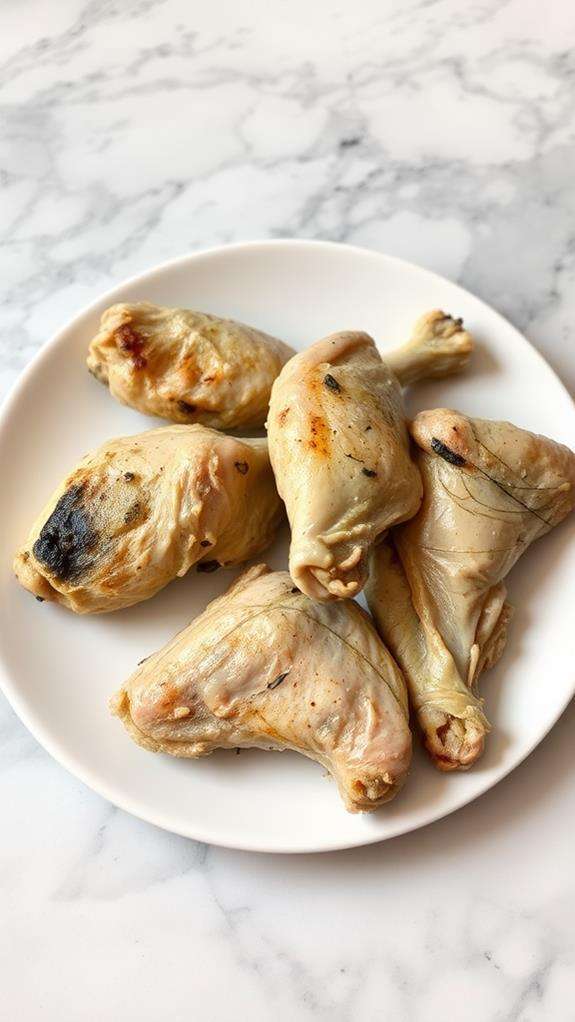
When checking wings for spoilage, rely on your senses to detect key warning signs. First, examine the color of your wings – fresh chicken wings should maintain a pink or light beige hue, while spoiled ones often develop a grayish-green tinge or unusual dark spots. It's also important to confirm that your wings have reached a safe internal temperature of 165°F (75°C) when cooked, as consuming undercooked wings can pose health risks from pathogens like Salmonella and Campylobacter cooked chicken safety. You'll also want to note any slimy texture on the surface, which indicates bacterial growth.
Your nose is an excellent detector of spoilage. If you notice any sour, rancid, or ammonia-like odors when opening the container, don't risk eating the wings. Fresh wings should have little to no odor, or just a mild chicken smell. Watch out for any fuzzy growth or mold, which can appear in white, green, or black patches on the meat's surface.
The texture's another vital indicator – if your wings feel unusually sticky or tacky to touch, that's a red flag. You might also notice that the meat has become mushy or that the skin has separated from the meat. If you observe any of these signs, it's best to err on the side of caution and discard the wings immediately.
Freezing Wings for Later
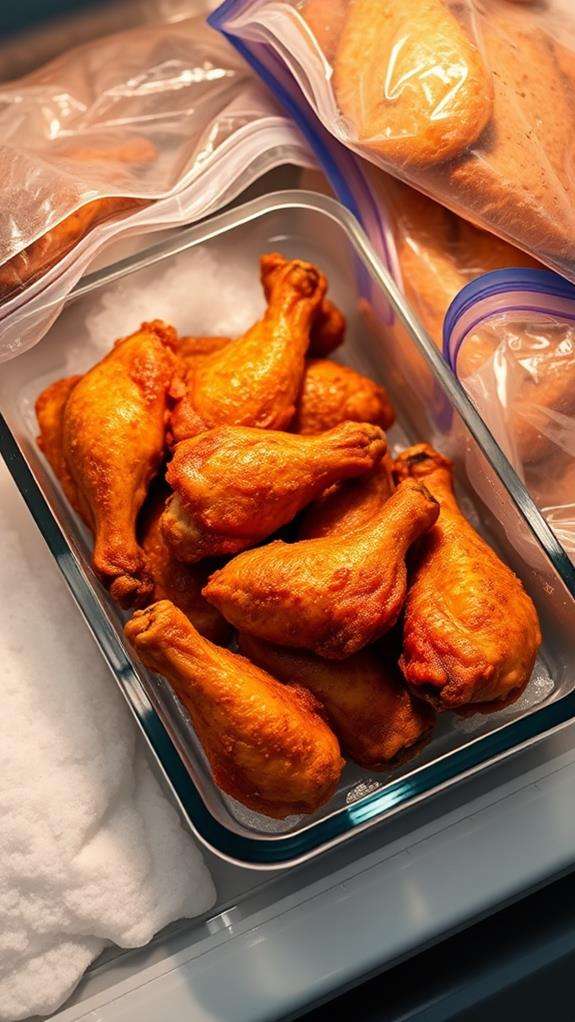
To safely freeze your leftover wings, you'll want to wrap them tightly in plastic wrap or aluminum foil before placing them in an airtight, freezer-safe container or heavy-duty freezer bag. While properly stored wings can last up to 6 months in the freezer at 0°F (-18°C), you'll get the best quality and flavor if you consume them within 2-3 months. For best results when freezing, remove as much air as possible from the packaging to prevent freezer burn, and label the container with both the date of freezing and the number of wings inside.
Storage and Prep Tips
Freezing leftover wings will extend their shelf life up to 6 months when stored properly. Before freezing, you'll want to verify your wings have cooled completely to room temperature, as placing warm food in your freezer can affect the temperature stability and potentially compromise other frozen items.
For peak storage results, follow these essential steps:
- Double-wrap your wings first in plastic wrap, then in heavy-duty aluminum foil to prevent freezer burn and maintain moisture
- Label each package with the date of freezing and contents using a permanent marker
- Store wings in meal-sized portions to avoid repeated thawing and refreezing
- Place wrapped wings in freezer-safe, airtight containers for additional protection
When you're ready to enjoy your frozen wings, transfer them to your refrigerator and allow them to thaw gradually for 24-48 hours. Don't thaw wings at room temperature, as this can promote bacterial growth. Once thawed, reheat your wings in a 350°F oven until they reach an internal temperature of 165°F, which typically takes 15-20 minutes. You'll want to avoid using the microwave, as it can make the skin rubbery.
Best Freezing Timeframes
A wing's perfect freezing window depends on several key factors, including preparation method and packaging quality. When you've properly sealed your wings in airtight, freezer-safe containers or heavy-duty freezer bags, you'll get the best results within specific timeframes.
For cooked wings, you can expect them to maintain peak quality for up to 4 months in the freezer when stored at 0°F (-18°C) or below. If you're freezing raw wings, you'll get a slightly longer storage window of 6 to 9 months. While they'll remain safe indefinitely at constant freezer temperatures, their texture and flavor will gradually decline after these periods.
To maximize your wings' freezer life, you'll want to remove as much air as possible from the packaging before freezing. If you're storing multiple servings, separate them into portion-sized amounts before freezing – this way, you won't need to thaw more than you plan to eat. For best results, label your containers with the freezing date and consume them within the recommended timeframe to guarantee you're getting the best quality possible when you decide to reheat them.
Proper Reheating Methods
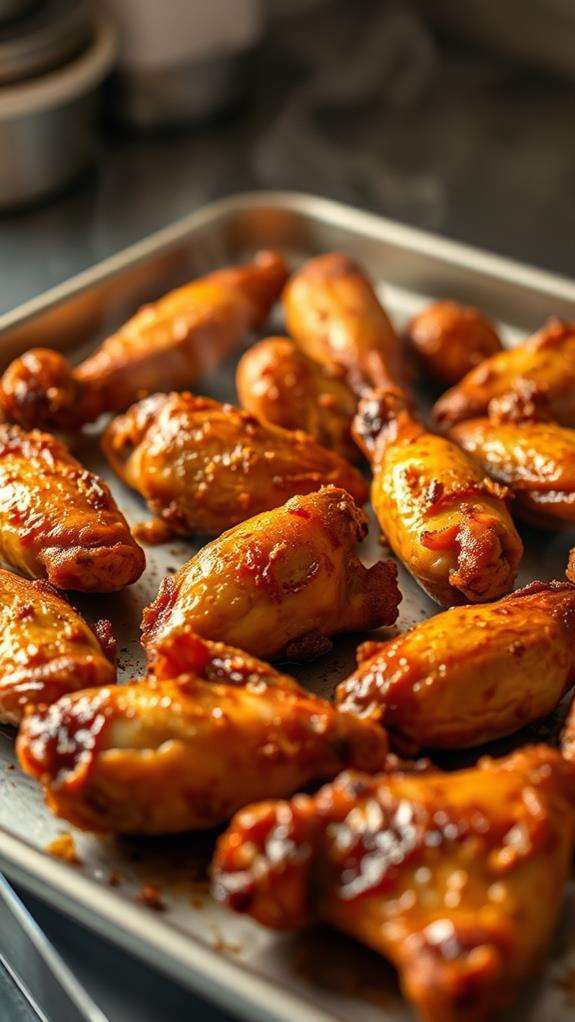
When it's time to reheat your leftover wings, choosing the right method makes all the difference in preserving their taste and texture. You'll want to avoid the microwave when possible, as it can make your wings rubbery and unevenly heated.
Here are the most effective methods for reheating wings:
- Use an air fryer at 375°F for 5-7 minutes, flipping halfway through for ideal crispiness and even heating
- Place wings in a preheated 350°F oven for 10-15 minutes on a wire rack over a baking sheet to maintain crispiness
- Pan-fry wings on medium heat for 2-3 minutes per side, adding a splash of water and covering briefly to create steam
- Broil wings for 2-3 minutes per side, watching carefully to prevent burning while achieving a crispy exterior
For sauce-covered wings, you'll want to add any additional sauce after reheating to prevent burning. If you're working with frozen wings, make sure to thaw them completely in the refrigerator before reheating. Remember to check that the internal temperature reaches 165°F for food safety, using a meat thermometer for accuracy.
Restaurant Vs Homemade Wings
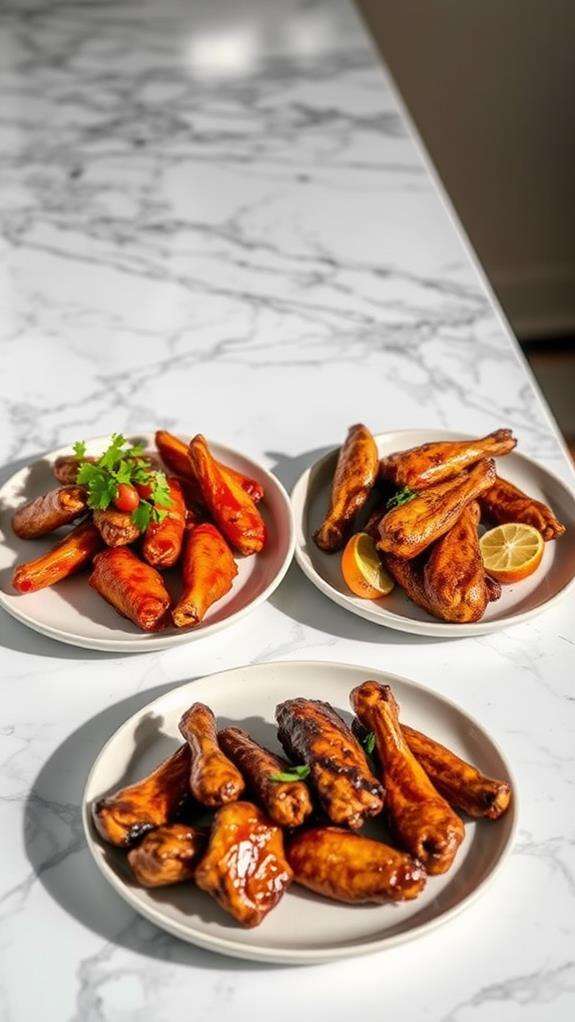
Many people debate whether restaurant or homemade wings deliver better quality and value. When you're deciding between the two options, you'll find distinct advantages to each. Restaurant wings often benefit from commercial-grade fryers, specialized equipment, and time-tested recipes that can be hard to replicate at home. Additionally, enjoying homemade chicken dishes allows you to explore chicken salad variations that enhance your meal experience with creative flavors.
However, you'll typically save money by making wings at home, where you can control the quality of ingredients and customize flavors to your exact preferences. Home preparation allows you to monitor the freshness of your chicken, choose organic options if desired, and adjust seasoning levels. You're also able to control the cooking oil's quality and temperature more precisely.
Restaurant wings do offer convenience and consistency, particularly from established chains that have perfected their processes. They'll often use proprietary sauce blends and cooking techniques that create signature flavors. But you're paying for overhead costs, labor, and profit margins. When making wings at home, you can buy in bulk during sales, experiment with different cooking methods like air frying or baking, and prepare larger quantities for less money per serving.
Frequently Asked Questions
Can I Eat Wings That Were Left in My Car Overnight?
You shouldn't eat wings that have been left in your car overnight. Bacteria multiply rapidly between 40°F and 140°F (the "danger zone"), and your car creates a perfect environment for bacterial growth. Even if they look and smell fine, these wings could harbor dangerous pathogens like Salmonella or E. coli. To stay safe, you should always refrigerate cooked wings within two hours, or within one hour if it's above 90°F outside.
Do Boneless Wings Have the Same Shelf Life as Bone-In Wings?
You might think boneless wings would last longer since they're just chicken nuggets in disguise, but they actually have the same shelf life as bone-in wings. Both types should be refrigerated within 2 hours and consumed within 3-4 days. The presence of bones doesn't affect storage time – it's all about temperature control and proper storage. You'll want to keep them in an airtight container at 40°F or below.
Should Leftover Wings Be Stored With or Without Sauce?
You'll want to store your leftover wings without sauce whenever possible, as sauces can make the breading or skin soggy and potentially reduce shelf life. If your wings are already sauced, you can still store them, but they won't maintain their texture as well. Store them in an airtight container, and if you're planning to reheat them later, consider keeping extra sauce separately to add fresh when reheating.
Can I Feed Leftover Chicken Wings to My Pets?
You shouldn't feed leftover chicken wings to your pets, especially dogs and cats. The bones can splinter and cause serious internal injuries, while seasonings, sauces, and spices can be toxic to animals. If you'd like to share chicken with your pets, you can give them plain, cooked chicken meat without bones, skin, or seasonings. Always consult your veterinarian before introducing new foods to your pet's diet.
Do Different Wing Sauce Flavors Affect How Long Wings Stay Fresh?
Yes, different wing sauces can impact your leftovers' shelf life. Oil-based and vinegar-based sauces tend to preserve wings longer, while cream-based or sweet sauces spoil more quickly due to their dairy and sugar content. You'll want to eat wings with ranch or blue cheese-based sauces within 2-3 days, while buffalo or hot sauce wings might last 3-4 days when properly refrigerated. Store all wings in airtight containers below 40°F.





